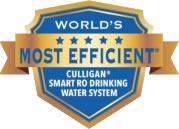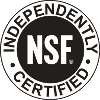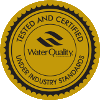Most people don’t realize it, but tap water can contain dozens of contaminants with potentially serious health effects. So we created this page to help you informed regarding water quality in the Houston area.
Contaminants Detected in Houston Tap Water
-
46 Total Contaminants Detected
-
10 Contaminants Exceed EWG Health Guidelines
Important facts to know about water quality safety:
The EWG teaches that legal water levels are not necessarily safe. Federal guidelines have not been updated in almost 20 years, and do not reflect the latest health guidelines. If you want to ensure healthy drinking water for your family, it’s up to you to learn about your local water supply, and take the steps necessary to remove potentially harmful contaminants.
Contaminants Detected in Houston Water That Exceed Health Guidelines
Arsenic
Exceeds Health Guidelines By…
508x
- Legal Limit: 10 ppb
- Health Guidelines: 0.004 ppb
- Houston Water: 2.03 ppb
Bromodichloromethane
Exceeds Health Guidelines By…
98x
- Legal Limit: None
- Health Guidelines: 0.06 ppb
- Houston Water: 5.88 ppb
Chloroform
Exceeds Health Guidelines By…
40x
- Legal Limit: None
- Health Guidelines: 0.4 ppb
- Houston Water: 16.1 ppb
Chromium
Exceeds Health Guidelines By…
37x
- Legal Limit: None
- Health Guidelines: 0.02 ppb
- Houston Water: 0.747 ppb
Dibromochloromethane
Exceeds Health Guidelines By…
16x
- Legal Limit: None
- Health Guidelines: 0.1 ppb
- Houston Water: 1.59 ppb
Dichloroacetic Acid
Exceeds Health Guidelines By…
26x
- Legal Limit: None
- Health Guidelines: 0.7 ppb
- Houston Water: 18.1 ppb
Radium
Exceeds Health Guidelines By…
27x
- Legal Limit: 5 pCi/L
- Health Guidelines: 0.05 pCi/L
- Houston Water: 1.34 pCi/L
Trihalomethanes (TTHMs)
Exceeds Health Guidelines By…
219x
- Legal Limit: 80 ppb
- Health Guidelines: 0.15 ppb
- Houston Water: 32.8 ppb
Trichloroacetic Acid
Exceeds Health Guidelines By…
12x
- Legal Limit: None
- Health Guidelines: 0.5 ppb
- Houston Water: 6.04 ppb
Uranium
Exceeds Health Guidelines By…
4.4x
- Legal Limit: 20 pCi/L
- Health Guidelines: 0.43 pCi/L
- Houston Water: 1.89 pCi/L
Other Contaminants Detected in Houston Water
- 1,2,3-Trichloropropane, 0.000345 ppb
- 1,4-Dioxane, 0.00599 ppb
- Acetone, 0.768 ppb
- Aluminum, 52.5 ppb
- Atrazine, 0.100 ppb
- Barium, 162.9 ppb
- Bromochloroacetic acid, 4.92 ppb
- Bromoform, 0.259 ppb
- Chlorate, 31.3 ppb
- Chloromethane, 0.0248 ppb
- Chromium, 0.138 ppb
- Cobalt, 0.0106 ppb
- Cyanide, 15.1 ppb
- Di(2-ethylhexyl) phthalate, 0.142 ppb
- Dibromoacetic acid, 1.11 ppb
- Endrin, 0.000114 ppb
- Ethylbenzene, 0.0528 ppb
- Fluoride, 0.302 ppm
- Haloacetic acids (HAA5), 26.4 ppb
- Hexadecanoic acid, 3.65 ppb
- Manganese, 9.89 ppb
- Methyl isobutyl ketone, 0.497 ppb
- Metolachlor, 0.00830 ppb
- Molybdenum, 1.99 ppb
- Monobromoacetic acid, 0.00524 ppb
- Monochloroacetic acid, 1.17 ppb
- Nitrate, 0.210 ppm
- Nitrate and nitrite, 0.107 ppm
- Nitrite, 0.000345 ppm
- Octadecanoic acid, 13.0 ppb
- Selenium, 1.58 ppb
- Simazine, 0.0295 ppb
- Strontium, 361.5 ppb
- Toluene, 0.00800 ppb
- Vanadium, 1.91 ppb
- Xylenes, 0.431 ppb
What Can You Do To Improve The Quality Of Your Drinking Water?
If you’re like most people, you may be shocked to find out how many contaminants are present in our local water supplies. You may also be wondering: What can you do to provide cleaner, safer drinking water for yourself and your family?
Sadly, a simple filtration pitcher is NOT sufficient to remove all these contaminants.
But not to worry–Culligan is here to help. We have a range of water treatment options capable of eliminating up to 99.99% of common water contaminants.
Because everyone’s water can vary slightly, we recommend starting with a 100% free, no-obligation water test. We’ll send a water technician to your home at a convenient time to test your water and find out what’s in it.
This test is important in helping us to determine the best water treatment system for your water and your needs.
To schedule your free water test now, just call us or fill out this short form:
Request Your Free, No-Obligation Water Test
Real Texas Reviews:
The data on this page comes from the EWG’s Tap Water Database.






